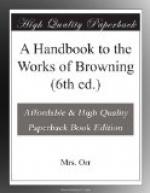So much of Mr. Browning’s moral influence lies in the hopeful religious spirit which his works reveal, that it is important to understand how elastic this is, and what seeming contradictions it is competent to unite. The testimony of one poem might otherwise be set against that of another with confusing results.
Mr. Browning’s paternal grandfather was an Englishman of a west country stock;[1] his paternal grandmother a Creole. The maternal grandfather was a German from Hamburg named Wiedemann, an accomplished draughtsman and musician.[2] The maternal grandmother was completely Scotch.
This pedigree throws a valuable light on the vigour and variety of Mr. Browning’s genius; for it shows that on the ground of heredity they are, in great measure, accounted for. It contains almost the only facts of a biographical nature which can be fitly introduced into the present work.
HIS CHOICE AND TREATMENT OF SUBJECT.
VERSIFICATION.
Mr. Browning’s choice of subject is determined by his belief that individual feeling and motive are the only true life: hence the only true material of dramatic art. He rejects no incident which admits of development on the side of feeling and motive. He accepts none which cannot be so developed. His range of subject covers, therefore, a great deal that is painful, but nothing that is simply repulsive: because the poetry of human life, that is of individual experience, is absent from nothing which he portrays.
His treatment of his subject is realistic in so far that it is always picturesque. It raises a distinct image of the person or action he intends to describe; but the image is, so to speak, always saturated with thought: and I shall later have occasion to notice the false impression of Mr. Browning’s genius which this circumstance creates. Details, which with realists of a narrower kind would give only a physical impression of the scene described, serve in his case to build up its mental impression. They create a mental or emotional atmosphere which makes us vaguely feel the intention of the story as we travel through it, and flashes it upon us as we look back. In “Red Cotton Night-cap Country” (as we shall presently see) he dwells so significantly on the peacefulness of the neighbourhood in which the tragedy has occurred, that we feel in it the quiet which precedes the storm, and which in some measure invites it. In one of the Idyls, “Ivan Ivanovitch,” he begins by describing the axe which will strike off the woman’s head, and raising a vague idea of its fitness for any possible use. In another of them, “Martin Relph,” the same process is carried on in an opposite manner. We see a mental agony before we know its substantial cause; and we only see the cause as reflected in it “Ned Bratts,” again, conveys in its first lines the sensation of a tremendously hot day in which Nature seems to reel in a kind of riotous stupefaction; and the grotesque tragedy on which the idyl turns, becomes a matter of course. It would be easy to multiply examples.




